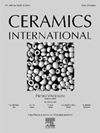

Journal TitleпјҡCeramics International
Ceramics International covers the science of advanced ceramic materials. The journal encourages contributions that demonstrate how an understanding of the basic chemical and physical phenomena may direct materials design and stimulate ideas for new or improved processing techniques, in order to obtain materials with desired structural features and properties.
Ceramics International covers oxide and non-oxide ceramics, functional glasses, glass ceramics, amorphous inorganic non-metallic materials (and their combinations with metal and organic materials), in the form of particulates, dense or porous bodies, thin/thick films and laminated, graded and composite structures. Process related topics such as ceramic-ceramic joints or joining ceramics with dissimilar materials, as well as surface finishing and conditioning are also covered. Besides traditional processing techniques, manufacturing routes of interest include innovative procedures benefiting from externally applied stresses, electromagnetic fields and energetic beams, as well as top-down and self-assembly nanotechnology approaches. In addition, the journal welcomes submissions on bio-inspired and bio-enabled materials designs, experimentally validated multi scale modelling and simulation for materials design, and the use of the most advanced chemical and physical characterization techniques of structure, properties and behaviour.
Technologically relevant low-dimensional systems are a particular focus of Ceramics International. These include 0, 1 and 2-D nanomaterials (also covering CNTs, graphene and related materials, and diamond-like carbons), their nanocomposites, as well as nano-hybrids and hierarchical multifunctional nanostructures that might integrate molecular, biological and electronic components.
Ceramics International ж¶өзӣ–е…Ҳиҝӣйҷ¶з“·жқҗж–ҷзҡ„科еӯҰгҖӮиҜҘжқӮеҝ—йј“еҠұеұ•зӨәеҜ№еҹәжң¬еҢ–еӯҰе’Ңзү©зҗҶзҺ°иұЎзҡ„зҗҶи§ЈеҰӮдҪ•жҢҮеҜјжқҗж–ҷи®ҫ计并жҝҖеҸ‘еҜ№ж–°зҡ„жҲ–ж”№иҝӣзҡ„еҠ е·ҘжҠҖжңҜзҡ„жғіжі•зҡ„иҙЎзҢ®пјҢд»ҘиҺ·еҫ—е…·жңүжүҖйңҖз»“жһ„зү№еҫҒе’ҢжҖ§иғҪзҡ„жқҗж–ҷгҖӮ
Ceramics International ж¶өзӣ–ж°§еҢ–зү©е’Ңйқһж°§еҢ–зү©йҷ¶з“·гҖҒеҠҹиғҪжҖ§зҺ»з’ғгҖҒзҺ»з’ғйҷ¶з“·гҖҒж— е®ҡеҪўж— жңәйқһйҮ‘еұһжқҗж–ҷпјҲеҸҠе…¶дёҺйҮ‘еұһе’Ңжңүжңәжқҗж–ҷзҡ„з»„еҗҲпјүпјҢд»Ҙйў—зІ’гҖҒиҮҙеҜҶжҲ–еӨҡеӯ”дҪ“гҖҒи–„/еҺҡзҡ„еҪўејҸи–„иҶңе’ҢеұӮеҺӢгҖҒеҲҶзә§е’ҢеӨҚеҗҲз»“жһ„гҖӮиҝҳж¶өзӣ–дәҶдёҺе·Ҙиүәзӣёе…ізҡ„дё»йўҳпјҢдҫӢеҰӮйҷ¶з“·-йҷ¶з“·жҺҘеӨҙжҲ–з”ЁдёҚеҗҢжқҗж–ҷиҝһжҺҘйҷ¶з“·пјҢд»ҘеҸҠиЎЁйқўеӨ„зҗҶе’Ңи°ғиҠӮгҖӮйҷӨдәҶдј з»ҹзҡ„еҠ е·ҘжҠҖжңҜпјҢж„ҹе…ҙи¶Јзҡ„еҲ¶йҖ и·ҜзәҝиҝҳеҢ…жӢ¬еҸ—зӣҠдәҺеӨ–йғЁж–ҪеҠ еә”еҠӣгҖҒз”өзЈҒеңәе’Ңй«ҳиғҪжқҹзҡ„еҲӣж–°зЁӢеәҸпјҢд»ҘеҸҠиҮӘдёҠиҖҢдёӢе’ҢиҮӘз»„иЈ…зәізұіжҠҖжңҜж–№жі•гҖӮжӯӨеӨ–пјҢиҜҘжңҹеҲҠиҝҳж¬ўиҝҺжҸҗдәӨе…ідәҺд»ҝз”ҹе’Ңд»ҝз”ҹжқҗж–ҷи®ҫи®ЎгҖҒз»ҸиҝҮе®һйӘҢйӘҢиҜҒзҡ„жқҗж–ҷи®ҫи®ЎеӨҡе°әеәҰе»әжЁЎе’ҢжЁЎжӢҹпјҢд»ҘеҸҠдҪҝз”ЁжңҖе…Ҳиҝӣзҡ„з»“жһ„гҖҒжҖ§иҙЁе’ҢиЎҢдёәзҡ„еҢ–еӯҰе’Ңзү©зҗҶиЎЁеҫҒжҠҖжңҜзҡ„жҠ•зЁҝгҖӮ
дёҺжҠҖжңҜзӣёе…ізҡ„дҪҺз»ҙзі»з»ҹжҳҜ Ceramics International зҡ„зү№еҲ«е…іжіЁзӮ№гҖӮе…¶дёӯеҢ…жӢ¬ 0гҖҒ1 е’Ң 2-D зәізұіжқҗж–ҷпјҲиҝҳеҢ…жӢ¬ CNTгҖҒзҹіеўЁзғҜе’Ңзӣёе…іжқҗж–ҷд»ҘеҸҠзұ»йҮ‘еҲҡзҹізўіпјүгҖҒе®ғ们зҡ„зәізұіеӨҚеҗҲжқҗж–ҷпјҢд»ҘеҸҠеҸҜиғҪйӣҶжҲҗеҲҶеӯҗгҖҒз”ҹзү©е’Ңз”өеӯҗе…ғ件зҡ„зәізұіжқӮеҢ–зү©е’ҢеҲҶзә§еӨҡеҠҹиғҪзәізұіз»“жһ„гҖӮ
| еӨ§зұ»еӯҰ科 | е°Ҹзұ»еӯҰ科 | еҲҶеҢә | TopжңҹеҲҠ | з»јиҝ°жңҹеҲҠ |
| жқҗж–ҷ科еӯҰ | MATERIALS SCIENCE, CERAMICS жқҗж–ҷ科еӯҰпјҡзЎ…й…ёзӣҗ | 1еҢә | жҳҜ | жҳҜ |
| еӨ§зұ»еӯҰ科 | е°Ҹзұ»еӯҰ科 | еҲҶеҢә |
| жқҗж–ҷ科еӯҰ | MATERIALS SCIENCE, CERAMICS жқҗж–ҷ科еӯҰпјҡзЎ…й…ёзӣҗ | 1еҢә |
| жңҹеҲҠеҗҚз§° | йўҶеҹҹ | дёӯ科йҷўеҲҶеҢә | еҪұе“Қеӣ еӯҗ |
| Transactions Of Nonferrous Metals Society Of China | жқҗж–ҷ科еӯҰ | 1еҢә | 4.500 |
| Transactions Of Nonferrous Metals Society Of China | жқҗж–ҷ科еӯҰ | 1еҢә | 4.500 |
| Electrochemical Energy Reviews | жқҗж–ҷ科еӯҰ | 1еҢә | 31.300 |
| Npj Computational Materials | жқҗж–ҷ科еӯҰ | 1еҢә | 9.700 |
| International Materials Reviews | жқҗж–ҷ科еӯҰ | 1еҢә | 16.100 |
| Ndt & E International | жқҗж–ҷ科еӯҰ | 1еҢә | 4.200 |